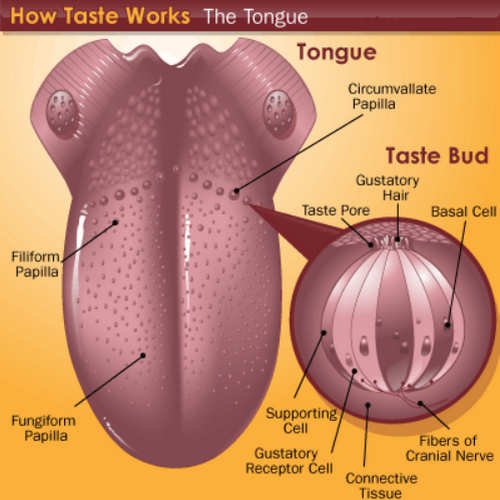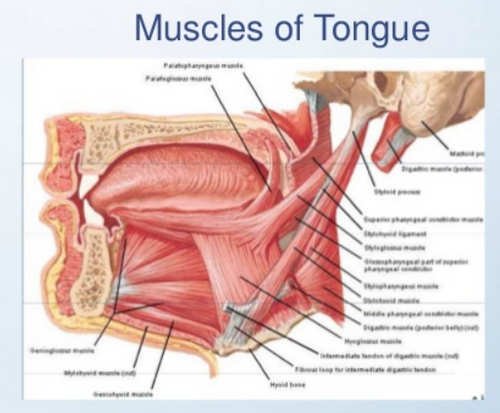Tongue Anatomy
The tongue is one of the five sensory organs of the body. It is a muscular organ covered with mucosa (moist pink tissues).
The tongue has a rough texture because of its papillae (tiny bumps). There are thousands of taste buds in the tongue. They are nerve-like cells connecting to the nerves into the brain. The four common tastes are sweet, salty, sour, and bitter. (1, 2)

Image 1: The human anatomy of the tongue
Picture Source: nursingcrib.com

Picture 2: The muscles of the tongue
Photo Source: image.slidesharecdn.com

Image 3: The different papillae of the tongue
Picture Source: image.slidesharecdn.com
The parts of the tongue and their functions
The tongue has three surfaces:
- Tip – It is the highly mobile part of the tongue, the pointed anterior part.
- Body – It is located in the posterior part of the tip. It has two surfaces: the ventral surface of the tongue and the dorsal part. It has a structure called median sulcus, which equally separates the tongue into left and right. It has another structure called terminal sulcus (groove). It is a V-shaped furrow separating the body from the base of the tongue. In its tip lies the foramen cecum, which is a remnant of the proximal thyroglossal duct.
- Base – It contains the lingual tonsils. (4, 10)
The papillae in the tongue
The surface of the tongue is rough because of the presence of lingual papillae. They are a projection of lamina propria covered with epithelium. There are different types of lingual papillae. These are:
- Vallate (circumvallate) – They are flat and prominent papillae surrounded by troughs. The human tongue has 8 to 12 vallate papillae situated to the anterior terminal sulcus.
- Foliate – They are small folds of mucosa located in the lateral surface of the tongue.
- Filiform – They are thin and long found along the entire dorsum of the tongue.
- Fungiform – Their shapes are like mushrooms and a numerous number can be found along the tip and lateral surface of the tongue. There are 200 to 300 fungiform papillae in the human tongue. (2, 3, 4)
The muscles in the tongue
The tongue muscles are divided into two: the intrinsic and extrinsic muscles. The fibrous lingual septum separates the muscles on each side of the tongue.
Extrinsic muscles
They originate outside the tongue and insert within it. They alter the position of the tongue. The extrinsic muscles of the tongue include genioglossus, hyoglossus, styloglossus, and palatoglossus. (5)
Intrinsic muscles
They are found within and do not insert on the bones. They alter the shape of the tongue. Examples of intrinsic muscles of the tongue are superior and inferior longitudinal, transverse, and vertical. The superior longitudinal muscles lie beneath the mucous membrane.
They shorten the tongue and make the dorsum concave. The inferior longitudinal muscles lye close to the inferior muscles of the tongue. It lies between hyoglossus and genioglossus and responsible in shortening the tongue. On the other hand, the transverse muscle extends from the middle septum to the margins. Its function is to narrow and elongate the tongue.
The vertical muscle is situated at the borders of the anterior portion of the tongue. It is responsible in broadening and flattening the tongue. (6, 7)
The vessels in the tongue
The arterial blood supply of the tongue comes from the external carotid artery specifically the lingual artery. It gives rise to three main branches namely the dorsal lingual, deep lingual, and sublingual arteries.
- Dorsal lingual artery – It supplies blood to the base of the tongue.
- Deep lingual artery – It travels on the lower surface of the tongue going to the tip.
- Sublingual artery – it is the artery that braches to the sublingual gland and floor of the mouth.
- Deep lingual vein – It begins at the tip of the tongue and travels posteriorly joining the sublingual vein.
- Dorsal lingual vein
- Internal jugular vein (8)
The nerve supply
- Hypoglossal nerve – The hypoglossal nerve is the primary nerve of the tongue. It is responsible for all motor innervation of the muscles of the tongue.
- Lingual nerve – it is responsible for general sensation of the anterior 2/3 of the tongue. It is actually a division of the trigeminal nerve.
- Lingual tonsillar branch of the glossopharyngeal nerve – Responsible for the sensation of the posterior 2/3 of the tongue. (8, 9)
- Internal laryngeal branch of the superior laryngeal nerve – It is responsible in some general and taste sensation from the base of the anterior part of the tongue to the epiglottis.
Lymphatic Drainage
The tongue has a complex lymphatic drainage. The lymph on one side can reach the nodes of both sides of the neck. The lymphatic drainage consists of the following:
- Tip – It drains directly to deep cervical nodes or to the submental nodes.
- Central lymphatics – They drain to the deep cervical nodes of either sides.
- Posterior – The drain is direct and bilateral to the deep cervical nodes. The deep cervical nodes include both the jugulo-omohyoid nodes and the jugulodigastric nodes. (1, 3)
What are the functions of the tongue?
Taste
The primary function of the tongue is for tasting. It has taste buds and sensory receptors responsible for distinguishing taste. How does the tongue distinguish taste? A tastant, a chemical that stimulates taste receptor is dissolved in the saliva and gets in contact with the plasma membrane of the gustatory hairs, the site of taste transduction. (10)
Speech
The tongue has intrinsic muscles enabling and defining the shape of the tongue, which affects speech. Articulation primarily relies on the movement of the tongue. (10)
Mastication
The tongue plays a very important role in the digestive processes. It helps the teeth and other parts of the mouth with chewing foods for softening before swallowing. The tongue has the ability to grind against the hard palate without being irritated or damaged. (2, 6)
Cleaning
The tongue’s movement helps dislodge the particles of foods that are stuck in between the teeth and gums.
Intimacy
The tongue plays an important role in physical intimacy and sexuality. It is a part of the erogenous zone of the mouth. It can be used for intimate contacts. A perfect example is a French kiss. (4, 7)
References:
- www.webmd.com
- https://en.wikipedia.org
- www.healthhype.com
- https://slideshare.net
- www.innerbody.com
- www.purposegames.com
- www.oluwoleogunranti.com
- www.cancer.ca
- www.organsofthebody.com
- Anatomy & Physiology for Speech, Language, and Hearing By J. Anthony Seikel, David G. Drumright, Douglas W. King